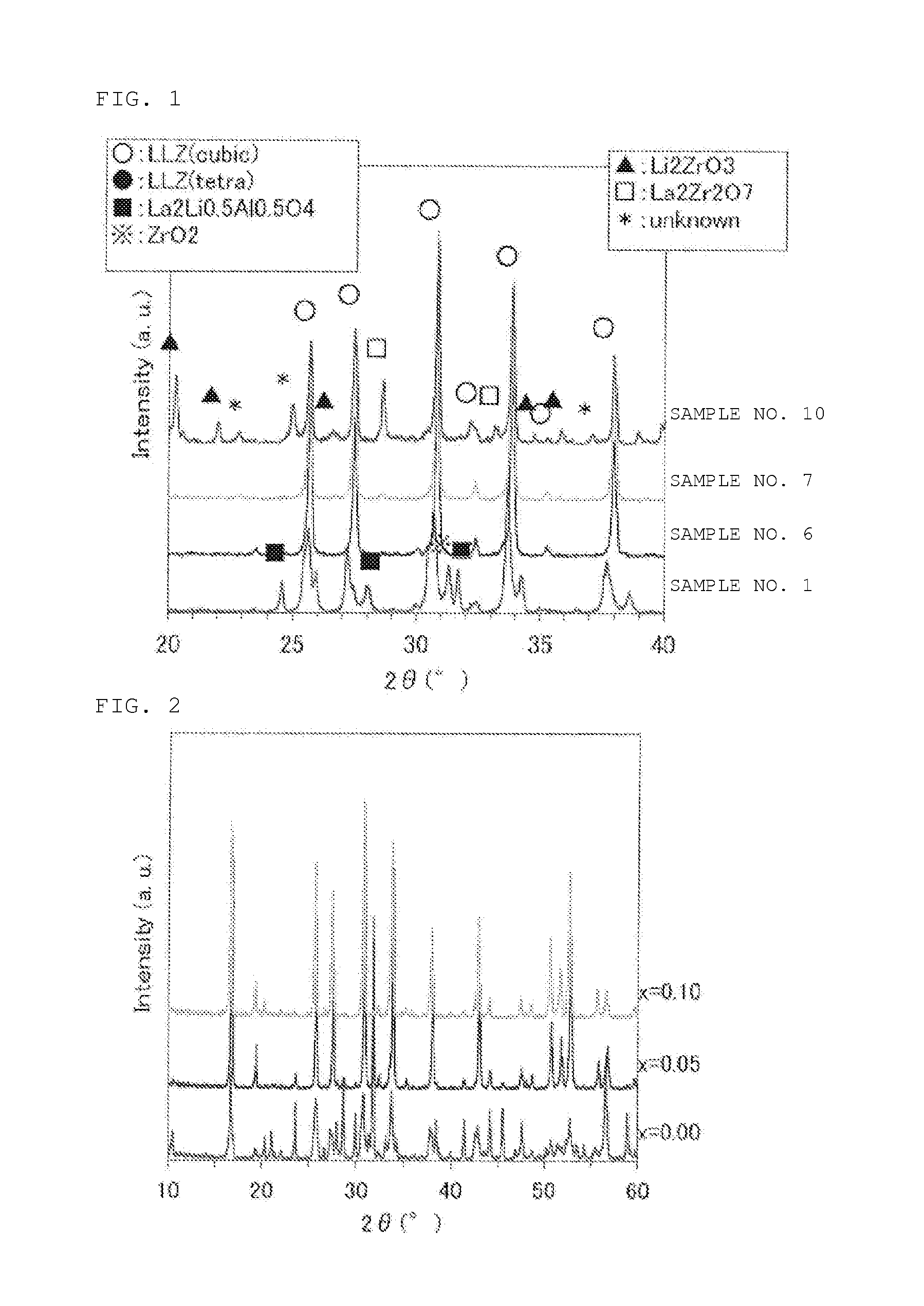Material for solid electrolyte
a solid electrolyte and material technology, applied in the direction of non-aqueous electrolyte cells, sustainable manufacturing/processing, final product manufacturing, etc., can solve the problems of inability to develop materials, inability to obtain desired solid electrolyte after sintering, and inability to achieve desired material design, etc., to achieve effective suppression or prevention of reaction, short time, effective suppression or prevention of undesired reaction
- Summary
- Abstract
- Description
- Claims
- Application Information
AI Technical Summary
Benefits of technology
Problems solved by technology
Method used
Image
Examples
example 1
[0080]As the starting materials, respective powders of Li2CO3, La(OH)3, ZrO2, Bi2O3, and Al2O3 (respectively having average grain size of about 0.5 μm) were used. First, the components other than Al2O3 were weighed to satisfy the value of x in the composition formula Li7(La1-xBix)3Zr2O12 as shown in Table 1, and mixed. Then Al2O3 was added in an amount of 1.2 parts by weight relative to 100 parts by weight of Li7(La1-xBix)3Zr2O12. These powders were mixed by wet mixing using zirconia balls, and dried, and then put into a magnesia container where it was calcined in atmospheric air at 1000° C. for 3 hours, to give calcined powder (present material). The obtained calcined powder was subject to powder X-ray diffraction analysis to identify its crystal phase. The result is shown in Table 1. The X-ray diffraction patterns of Sample number 1 (x=1), Sample number 6 (x=0.05), Sample number 7 (x=0.1), and Sample number 10 (x=0.3) in the form of calcined powder are shown in FIG. 1. Li7La3Zr2O1...
example 2
[0083]As the starting materials, respective powders of Li2CO3, La(OH)3, ZrO2, Bi2O3, and Al2O3 (respectively having average grain size of about 0.5 μm) were used. First, the components other than Al2O3 were weighed to satisfy x=0.00, 0.05 and 0.10 in the composition formula Li7.7(La1-xBix)3Zr2O12, and mixed. Then Al2O3 was added in an amount of 1.2 parts by weight relative to 100 parts by weight of Li7.7(La1-xBix)3Zr2O12. Calcined powder (average grain size: about 2 μm) was prepared in a similar manner as in Example 1 except that calcination was conducted at 900° C. for 3 hours. An X-ray diffraction pattern of the obtained calcined powder is shown in FIG. 2. As a result, in the case of x=0.00, tetragonal Li7La3Zr2O12, La2Zr2O7, and Li2CO3 were major constituting phases. On the other hand, in the cases of x=0.05 and x=0.10, it was confirmed that the pattern was as same as cubic Li7La3Zr2O12, and was composed of almost a single phase. In the composition of x=0.10, calcined powder was ...
example 4
[0085]As the starting materials, respective powders of Li2CO3, La(OH)3, ZrO2, Bi2O3, and Al2O3 (respectively having average grain size of about 0.5 μm) were used. First, the components other than Al2O3 were weighed to satisfy each composition shown in Table 3, and mixed. Then Al2O3 was added in an amount of 1.2 parts by weight relative to 100 parts by weight of each composition in Table 3. Calcination was conducted at 1000° C. for 3 hours in a similar manner as in Example 1, and crystal phase was identified by powder X-ray diffraction, and the same pattern as cubic system garnet type Li7La3Zr2O12 was observed. For Sample numbers 41 to 46 in Table 3, similarly to Example 1, calcined powder was wet ground and then molded, and then fired in atmospheric air at 1100° C. for 3 hours, to obtain a sintered body. The sintered density and the lithium ion conductivity are shown in Table 4.
TABLE 3SamplenumberComposition formula41Li6.95 (La2.90Bi0.10) (Zr1.95Bi0.05) O1242Li6.90 (La2.95Bi0.05) (Z...
PUM
| Property | Measurement | Unit |
|---|---|---|
| Grain size | aaaaa | aaaaa |
| Grain size | aaaaa | aaaaa |
| Temperature | aaaaa | aaaaa |
Abstract
Description
Claims
Application Information
 Login to View More
Login to View More - R&D
- Intellectual Property
- Life Sciences
- Materials
- Tech Scout
- Unparalleled Data Quality
- Higher Quality Content
- 60% Fewer Hallucinations
Browse by: Latest US Patents, China's latest patents, Technical Efficacy Thesaurus, Application Domain, Technology Topic, Popular Technical Reports.
© 2025 PatSnap. All rights reserved.Legal|Privacy policy|Modern Slavery Act Transparency Statement|Sitemap|About US| Contact US: help@patsnap.com


